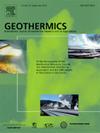Geospatial assessment of soil thermal conductivity for geothermal energy systems in Ecuador
IF 3.5
2区 工程技术
Q3 ENERGY & FUELS
引用次数: 0
Abstract
This study presents a detailed cartographic assessment of soil thermal conductivity in continental Ecuador using an adapted methodology based on the THERMOMAP project and Kersten's (1949) model. Soil thermal conductivity is essential for geothermal energy applications, particularly for designing efficient ground-source heat pump (GSHP) systems. Accurate mapping requires an analysis of soil texture, bulk density, and moisture content, applying mathematical correlations to estimate conductivity across different depths and regions. Climatic parameters (temperature and precipitation data from 2013–2022) and pedological data (soil texture and density) were processed through Geographic Information System (GIS) tools to create a thermal conductivity map. Results revealed soil thermal conductivity values ranging from 0.87 W/mK to 2.30 W/mK, with 95.34% of the surveyed area exhibiting values above 1.0 W/mK. Conductivity distribution was primarily within the ranges of 1.00–1.25 W/mK (54.36%) and 1.50–1.75 W/mK (33.48%). The Andean region demonstrated the highest geothermal potential, with 70.35% of its soils exceeding 1.25 W/mK, whereas coastal and eastern regions had lower proportions (37.99% and 28.10%, respectively). These findings align with previous research, highlighting significant variability driven by soil composition, moisture dynamics, and geological formations. The resulting map is valuable for identifying sites where knowledge of shallow soil thermal properties (less than 1 meter depth) is crucial for closed-loop geothermal system design. It supports optimal location selection for geothermal heat pumps, contributing to reliable heating and cooling in urban and rural areas, promoting sustainable energy diversification, and enhancing environmental sustainability in Ecuador.
厄瓜多尔地热能源系统土壤导热系数的地理空间评价
本研究采用了一种基于THERMOMAP项目和Kersten(1949)模型的改进方法,对厄瓜多尔大陆的土壤热导率进行了详细的制图评估。土壤导热性是地热能应用的关键,特别是设计高效的地源热泵系统。准确的测绘需要分析土壤质地、体积密度和水分含量,并应用数学相关性来估计不同深度和区域的电导率。通过地理信息系统(GIS)工具对气候参数(2013-2022年的温度和降水数据)和土壤学数据(土壤质地和密度)进行处理,生成导热系数图。结果表明:土壤热导率在0.87 ~ 2.30 W/mK之间,其中95.34%的调查区土壤热导率在1.0 W/mK以上;电导率分布主要在1.00 ~ 1.25 W/mK(54.36%)和1.50 ~ 1.75 W/mK(33.48%)之间。安第斯地区地热潜力最大,70.35%的土壤地热潜力超过1.25 W/mK,沿海和东部地区地热潜力较小,分别为37.99%和28.10%。这些发现与之前的研究一致,强调了土壤成分、水分动态和地质构造驱动的显著变化。由此产生的地图对于确定浅层土壤热特性(小于1米深)的知识对闭环地热系统设计至关重要的地点是有价值的。它支持地热热泵的最佳选址,有助于在城市和农村地区实现可靠的供暖和制冷,促进可持续能源多样化,并加强厄瓜多尔的环境可持续性。
本文章由计算机程序翻译,如有差异,请以英文原文为准。
求助全文
约1分钟内获得全文
求助全文
来源期刊

Geothermics
工程技术-地球科学综合
CiteScore
7.70
自引率
15.40%
发文量
237
审稿时长
4.5 months
期刊介绍:
Geothermics is an international journal devoted to the research and development of geothermal energy. The International Board of Editors of Geothermics, which comprises specialists in the various aspects of geothermal resources, exploration and development, guarantees the balanced, comprehensive view of scientific and technological developments in this promising energy field.
It promulgates the state of the art and science of geothermal energy, its exploration and exploitation through a regular exchange of information from all parts of the world. The journal publishes articles dealing with the theory, exploration techniques and all aspects of the utilization of geothermal resources. Geothermics serves as the scientific house, or exchange medium, through which the growing community of geothermal specialists can provide and receive information.
 求助内容:
求助内容: 应助结果提醒方式:
应助结果提醒方式:


